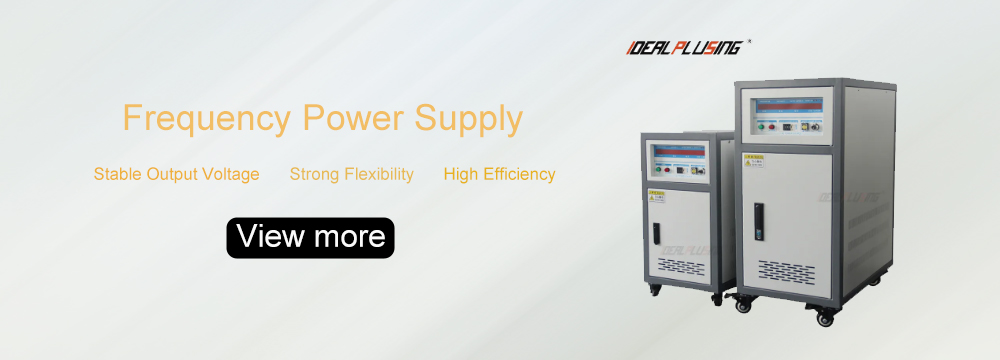As we all know, variable frequency power supply is divided into single-phase (single input and single output) power supply and three-phase (single input and three output, three input and three output) power supply. So what is the difference between single-phase and three-phase variable frequency power supply? Let's take a look at them together.
Variable frequency power supply is the rectification and inverter conversion of AC power in the power grid. The output is a pure sine wave, and the output frequency and voltage are adjustable within a certain range. According to the phase line, variable frequency power supply can be divided into single-phase variable frequency power supply and three-phase variable frequency power supply.
1. What is variable frequency power supply
Variable frequency power supply converts AC power in the city power through AC→DC→AC, and the output is a pure sine wave. The output frequency and voltage are adjustable within a certain range. It is different from the variable frequency speed controller used for motor speed regulation, and it is also different from the ordinary AC voltage stabilized power supply. The characteristics of an ideal AC power supply are stable frequency, stable voltage, zero internal resistance, and a pure sine wave voltage waveform (no distortion). The variable frequency power supply is very close to the ideal AC power supply. Therefore, advanced developed countries are increasingly using variable frequency power supplies as standard power supplies to provide the best power supply environment for electrical appliances and facilitate objective assessment of the technical performance of electrical appliances. There are two main types of variable frequency power supplies: linear amplification type and SPWM switching type.
2. Basic concepts of single frequency conversion and triple frequency conversion
Single frequency conversion, as the name suggests, refers to equipment that uses a single frequency conversion technology, which can usually only receive and process single-phase AC power. Triple frequency conversion refers to equipment that can receive and process three-phase AC power, with a wider range of applications and higher performance. These two frequency conversion technologies have their own advantages in practical applications, but triple frequency conversion has attracted much attention due to its advantages in some aspects.

3. What is the difference between single-phase and three-phase variable frequency power supplies
Single-phase variable frequency power supplies and three-phase variable frequency power supplies have significant differences in many aspects. The following is a detailed analysis of the differences between the two:
Three-phase variable frequency power supplies are divided into: three-input and three-output variable frequency power supplies, three-input and single-output variable frequency power supplies, single-input and single-output variable frequency power supplies, and three-phase variable frequency power supplies are in MPWM mode. Due to the design of the IGBT module of the active component, the machine can reach a capacity of 200 kVA. In order to improve the stability of the whole machine, the input and output of the transformer must be isolated, which is particularly suitable for inductive, capacitive and special loads. The reliability of load testing and life testing is very high.
Single-phase variable frequency power supply is also called single-input and single-output variable frequency power supply. The main circuit adopts AC, DC, AC voltage-frequency conversion circuit, which is mainly composed of rectification, filtering and inverter. The rectifier part uses a single-phase bridge rectifier module to realize AC/DC conversion. The filter connection uses a filter capacitor to stabilize the DC voltage. The inverter part uses a DIP-IPM intelligent power module to realize DC/AC conversion. The variable frequency power supply control loop is used to adjust the frequency and amplitude of the output signal of the power supply system to achieve variable voltage and frequency conversion. In order to ensure the safety and reliability of the system, overvoltage and undervoltage detection and protection circuits, optocoupler isolation drive circuits and auxiliary power conversion circuits are established.
3.1 Working principle:
Single-phase variable frequency power supply: When working, a phase shift circuit is required to divide the single-phase power supply voltage into two AC voltage signals, and then output AC power with adjustable voltage and adjustable frequency to the load through components such as switch tubes and IGBTs. This usually involves SPWM pulse width modulation technology, which controls the output voltage and frequency by adjusting the AC SPWM pulse width modulation.
Three-phase variable frequency power supply: It is based on three-phase AC power supply through two-stage filtering and conversion through components such as capacitors and inductors. It is made in MPWM mode and designed with active component IGBT modules, so that the capacity of this machine can reach 200KVA, and the stability of the whole machine is increased by isolating the input and output of the transformer.
3.2 Scope of application:
Single-phase variable frequency power supply: Due to the limitation of single-phase power supply, it is mainly suitable for small household appliances and light-load equipment. Single-phase variable frequency power supply can realize stepless adjustment of voltage and frequency, which is suitable for the needs of different loads and is widely used in industrial automation, medical equipment, communication equipment, laboratory calibration measurement and other fields.
Three-phase variable frequency power supply: suitable for industrial production lines and other heavy-load equipment, and can meet the requirements of high power output. It has the advantages of smooth output current and strong carrying capacity, and overcomes the problems of poor carrying capacity and poor stability of single-phase variable frequency.
(1) High measurement accuracy, suitable for similar tests of current half-sine wave and various waveforms with DC components;
(2) Provide embedded intelligent PC monitoring system;
(3) Adjustable output voltage in the entire range of 0-150 V, 0-300 V, in increments of 0.1 V;
(4), output frequency 45-120 Hz (optional 40-500 Hz), step 0.1 Hz;
(5), output current limiting function;
(6), through 9 storage groups, you can save commonly used parameters for easy call-up during use.
(7) Through RS232C communication interface [IEEE488.2 (GPIB) optional], the command execution time is less than 1 ms.
(8) Protection mode: overvoltage, overcurrent, overload, short circuit, current limiting, etc.;
(9) Provides readings of RMS voltage, RMS current, active power, frequency, power factor, etc.;
(10) Through 100% load release, the voltage stability response time is within 2 ms, the overload capacity is high, and the instantaneous current can withstand three times the rated current.
(11) Voltage, frequency, time, digital key input, high accuracy;
(12) The device can run 30 different voltage, frequency, rise time and running time settings at the same time, and continuously test and run 999999 times.
3.3 Performance characteristics:
Single-phase variable frequency power supply: has the advantages of stable output voltage, adjustable output frequency and high efficiency. It usually consists of three parts: rectifier, filter and inverter. The rectifier converts the input AC power into DC power, the filter smoothes the DC power, and the inverter adjusts the output voltage and frequency through SPWM pulse width modulation technology.
Three-phase variable frequency power supply: It has high-frequency MPWM design, IGBT power drive, small size, high reliability and low noise. Its efficiency is more than 85%, and it responds quickly. For 100% unloading/loading, the voltage stabilization response time is within 2ms. In addition, it also has the advantages of strong overload capacity and high peak factor ratio, and has multiple protection and alarm devices such as overvoltage, overcurrent, and overtemperature.
In summary, there are significant differences between single-phase variable frequency power supply and three-phase variable frequency power supply in terms of working principle, scope of application and performance characteristics. Which power supply to choose depends on the specific application scenario and needs.
4. Single three-phase power supply characteristics
The variable frequency power supply is divided into the following types: single-input single-output variable frequency power supply, three-input single-output variable frequency power supply, and three-input three-output variable frequency power supply
a. Characteristics of single-input single-output variable frequency power supply:
Output power: (500VA-120KVA), output voltage {0-150V/0-300V), output frequency (40HZ-499HZ)
b. Three-input single-output variable frequency power supply:
Output power: (3KVA -300KVA), output voltage (0-150/0-300V), output frequency (40HZ-499HZ)
c. Three-input and three-output variable frequency power supply:
Output power: (3KVA-300KVA), output voltage (0-260/0-520V), output frequency (40HZ-499HZ)
IGBT/PWM variable frequency power supply features:
1. Input frequency: 50Hz, 60 Hz
2. Output voltage: 0~300VAC.
3. Output frequency: 40-499.9Hz programmable finger setting.
4. Voltage, frequency, current, and power meters use 4-digit LED display, simple, easy to read, and high resolution.
5. Voltage (V), frequency (Hz), current (A), power (W) 4 windows are measured and displayed simultaneously, no switching is required.
6. No radiation interference, small harmonic components, and special treatment, no interference.
7. Pure and stable sine wave output.
8. Large capacity, small size, light weight, high efficiency; silent device, high reliability.
9. Provide standard voltage, frequency, and simulation tests for various electrical products in various countries in the world.
10. Strong overload capacity. Withstand 3 times the rated current for instantaneous current.
11. With overcurrent, overtemperature, short circuit, instantaneous power failure protection and warning devices.
12. Suitable for resistive, capacitive, inductive and other non-linear loads.
Share our interesting knowledge and stories on social media














